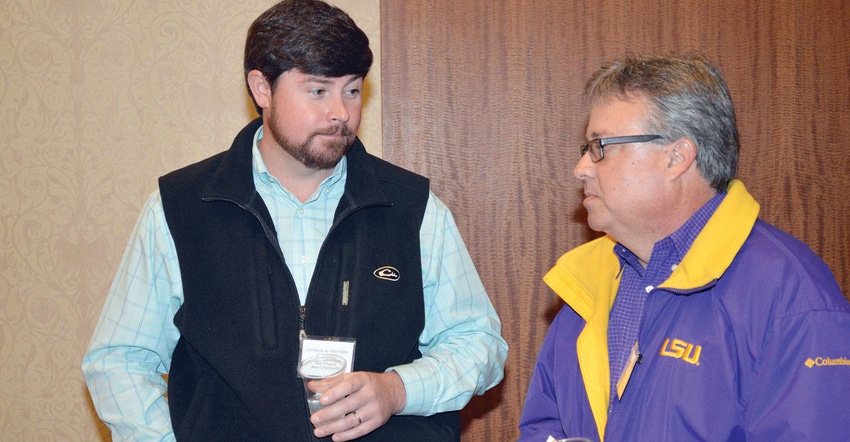February 3, 2019

The LSU AgCenter recognizes the need for a strong presence of distribution and retail outlets for seed, fertilizer and crop protection products across Louisiana, AgCenter associate vice president Rogers Leonard said speaking to agriculture industry leaders at the Louisiana Ag Industry Association convention held Jan. 22-23 in Marksville, La.
“We appreciate the opportunity to support these industries with our research and extension programs,” Leonard said.
A number of AgCenter experts took part in the two-day meeting to provide updates on herbicide application challenges, drone technologies and the 2019 market outlook.
The Louisiana Ag Industries Association is a nonprofit association with member representatives from chemical, fertilizer, seed, and grain and feed industries across Louisiana who promote and support agricultural activities and fair trade regulations, said Donna Morgan, AgCenter conservation agronomy agent who also serves as executive secretary for the association.
“Every year we get more cases documenting weed resistance in herbicides,” said AgCenter weed scientist Donnie Miller.
Two key challenges with any herbicide application are controlling drift and volatility, Miller said.
Miller served with a panel of experts from BASF, the Louisiana Department of Agriculture and Forestry and Bayer Crop Science to discuss issues related to new herbicide technologies, specifically dicamba-resistant crops.
Potential to volatize
While all herbicide applications can drift when applied incorrectly, only some have the potential to volatilize, changing form and moving off target, Miller said.
Education and training can help mitigate drift issues, he said, but Mother Nature pulls the strings when environmental conditions change and volatility issues arise.
Citing research from Tennessee, Miller said the addition of glyphosate to dicamba formulations has been shown to decrease the pH of the spray solution, increasing the potential volatility and resulting in recommendations to avoid adding glyphosate to tank mixes with dicamba formulations.
“We are not making this recommendation in Louisiana as of yet,” he said, adding that the information may be helpful for some producers in dealing with this issue.
LDAF director of pesticide and environmental programs Kevin Wofford said an inversion or volatilization is considered a form of drift under LDAF rules because the product has actually moved.
“The label is the law in Louisiana,” Wofford said.
The LDAF requires manufacturers to provide training to sell, purchase or apply dicamba products, and the U.S. Environmental Protection Agency has issued stricter guidelines for 2019, he said.
Trade top priority
“In the last 10 days, the state of Louisiana has been a worldwide epicenter for agriculture,” said Louisiana Commissioner of Agriculture and Forestry Dr. Mike Strain.
Strain said trade remains a top priority in agriculture, and it is important to level the playing field, especially as the amount of food production gets tighter compared to consumption.
“Each and every trade deal is important,” he said, adding that the U.S. is the largest exporter of food in the world.
Disruptions to cotton, corn and soybean markets as a result of the trade tariff situation continue to impact export projections for the 2018-19 marketing year, said AgCenter economist Michael Deliberto.
“The market will need to see increase in demand from China, Turkey and/or India to find additional demand and price support heading into 2019,” he said.
While U.S. cotton exports are projected to decrease 5 percent but still remain at 15 million bales, farm prices for U.S. cotton are expected to be higher in 2018-19 from lower production and exports above the 15 million bale level, he said.
A tightening global corn inventory may forecast lower production estimates, which could increase price pressure, he said, adding that U.S. corn prices have been trending upward.
“U.S. soybean prices will again be challenged in 2019 as trade disputes, disruptions in global trade flows, large global inventories and slow economic growth among major U.S. trading partners continue,” Deliberto said.
Drones
AgCenter engineer Randy Price shared research updates on the use of unmanned aerial systems in agriculture, more commonly referred to as drones.
“You don’t really need a high-end system to do farming-type work,” Price said.
For crop scouting and general farm use, a lower-cost retail multirotor type drone with appropriate software and tablet can perform and produce quality images without having to invest in more expensive airplane-type systems, Price said.
Although spray drones have limited use in the U.S. and require more extensive licensing, they are receiving more attention.
“They do seem to push the spray down and out,” Price said, adding that the spray width on a two-nozzle drone may be nearly 6 feet wide. “You wouldn’t get that on your spray rig, and this is at 10 feet high,” he said.
AgCenter publications No. P3633: Build Your Own Sprayer Drone and No. P3659: Low-Cost Drone Mapping System for Crop Scouting are available on the AgCenter website www.lsuagcenter.com.
Source: LSU AgCenter, which is solely responsible for the information provided and is wholly owned by the source. Informa Business Media and all its subsidiaries are not responsible for any of the content contained in this information asset.
About the Author(s)
You May Also Like




